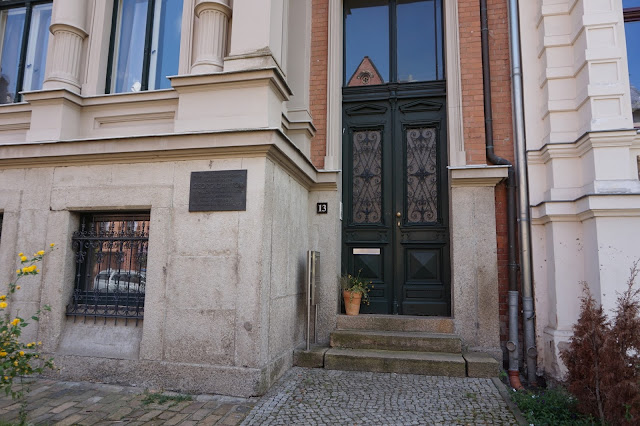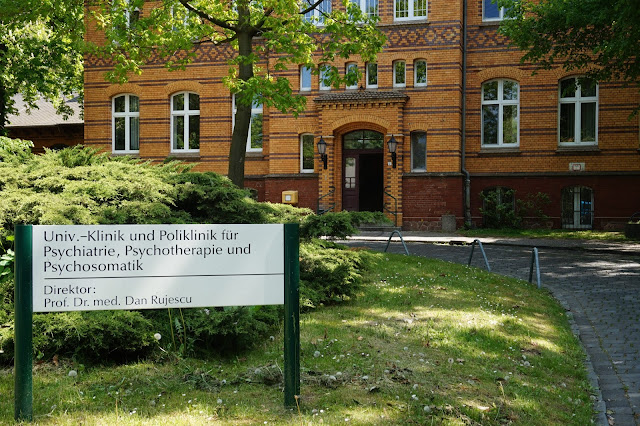Really? Well, not as far as I know - unless this tagger had proven something that would really shake up the mathematics community!
Here is the correct equation - and Cantor and me - at "The Cube" in Halle, Germany, where one side is dedicated to my favorite mathematician, Georg Cantor (1845-1918).

Cantor is my favorite mathematician, in part, because of his work with the infinite. Before continuing with this post I have a question for you. First, I want you to think about the counting numbers: 1, 2, 3, 4, 5, 6, 7, 8, 9, 10, 11 and so on. Now imagine removing all the odd numbers, so that you are left with only even numbers: 2, 4, 6, 8, 10, 12, and so on.
I said "and so on" at the end of each list, because each list is infinite; neither of them end. But to get the even numbers you removed half the numbers from the first list - so are there fewer numbers in the second list because half were removed? Or are there the same amount of numbers in both lists because they are both infinite, and infinity is just infinity?
SPOILER ALERT: Before the end of the post I will be giving away the answer as well as other related answers, so if you want to think about it on your own first, maybe move on to another post and come back to this one later.
Below are some photos of Cantor's home on 13 Handel Strasse in Halle. It is now part of a row of houses, but when he moved to Halle and had it built it was built in a "green area," so it was one of the first homes and had yard space around it.
Cantor did very original work in mathematics, pioneering set theory and the theory of transfinite numbers. Bold new work often brings out both admiration and anger. Cantor's former teacher and mentor Leopold Kronecker, who, as it turns out, had a very different philosophy of mathematics than Cantor was appalled by his work. The forms that Kronecker's responses took felt like persecution to Cantor.
Some other extremely prominent mathematicians of the day were also very negative towards his work. One of these was Henri Poincare, who referred to Cantor's work as a "grave malady" from which someday mathematics would be cured. Kronecker called Cantor a "renegade," a "scientific charlatan," and a "corrupter of the youth."
Others were supportive and more! David Hilbert said, "No one shall expel us from the Paradise that Cantor has created."
Cantor felt persecuted by the negative responses (and issues of not being allowed to publish certain articles in certain journals as well as not being able to get a position in Berlin, which he really desired). I'm compressing a lot of biography here, but Cantor also got hit with a number of personal traumas - the death of his mother in 1896, and the death of his son in 1899. Additionally, it turns out that one of the main problems Cantor was working on (the Continuum Hypothesis) turned out to be impossible to prove (something that wasn't shown until well after his death). What I'm leading up to in writing all this is that Cantor ended up struggling with bouts of depression. It is very likely that he had bipolar disorder; recent scholarship bears this out, but this wasn't a diagnosis he was given during his struggle in the early 1900s. He ended up spending time on and off in the sanatorium or "nervenklinik" - eventually dying there - of a heart-attack - in 1918. (I'm sure it didn't help that leading up to this it had been hard to get nutritious food; this was in Germany during the time of World War I.)
Below are some pictures of the "nervenklinik" where he was treated and where he died during his last stay there. It has been refurbished inside and out, of course, since 1918, but this is the same location and same hospital.
So, have you been thinking about that question about the size of the set of counting numbers and the size of the set of even numbers?
WARNING - ANSWER - The sets are the same size. This can be shown pretty easily by using the common sense idea of "one-to-one correspondence." For instance, I can put my hands together and match up all my fingers: thumb to thumb, pointer to pointer, all the way to pink to pinky. This is one way that I can show I have the same number of fingers on each hand. We can also match up the counting numbers with the even numbers. If you apply a rule to every counting number - the rule "times two" you get an even number. If you apply the rule "divided by two" to ever even number you get a counting number. So for every counting number there is a unique even number that matches it (its double!), and for every even number there is a unique counting number that matches it (its half!).
That was a pretty quick explanation. If you're interested and would like to talk further, please see me. It's much easier in person!
One more question, but I won't make you think about it too long: what about the size of the set of counting numbers compared to the size of the set of fractions? There are infinitely many fractions in-between every counting number, so shouldn't there be more fractions than counting numbers? Here too Cantor was able to show that the sets are the same size. (His proof is represented abstractly by the image with the circles and arrows on "The Cube" pictured at the top of this post and below.)
So now it sounds like infinity is just infinity and that you can't have bigger and smaller ones.
Well, it turns out there are infinities bigger than the infinity of the counting numbers.
I'll leave it at that and let those of you who want to look into it further do so. There are excellent books on this topic - and thousands of pages on the internet - and, if you know me, please come up to me and ask. I'd be MORE than happy to explain it all :-)
As you can imagine, though, since Cantor was pioneering these ideas and was being harassed to some degree and feeling persecuted, that combination probably triggered some of his episodes of depression. Galileo is someone else who had contemplated issues of size with regard to infinite sets. He did so in a work that was published in 1638, and his conclusion was that terms like "greater than," "less than," and even "equal to" could not be applied to what we now call infinite sets. The great Galileo could not get to the point that Cantor did, but Cantor boldly pressed forward, even against opposition. At some point I need to go back and verify the following, but I recall having read something about Galileo saying that the infinite was beyond the realm of humans and that we needed to leave it to God. Well, Cantor went to that realm and gave it to humans.
 |
| Cantor's tombstone - along with other family members - |
 |
| The stones on either side are for relatives of Cantor |
Think what you will of Cantor's infinities (though as you do so, do be aware that these ideas are part of standard mathematics and that his work with set theory is now part of what is called "foundations of mathematics"). As for me, I'm with Hilbert:
"No one shall expel us from the Paradise that Cantor has created."













No comments:
Post a Comment